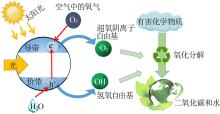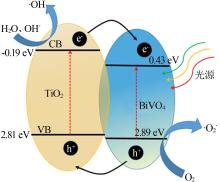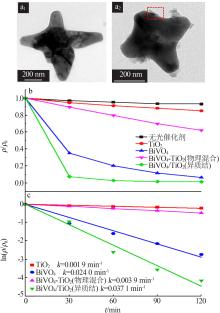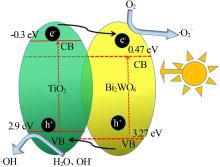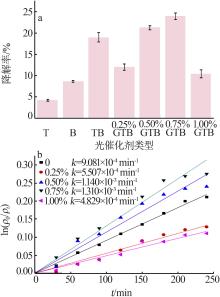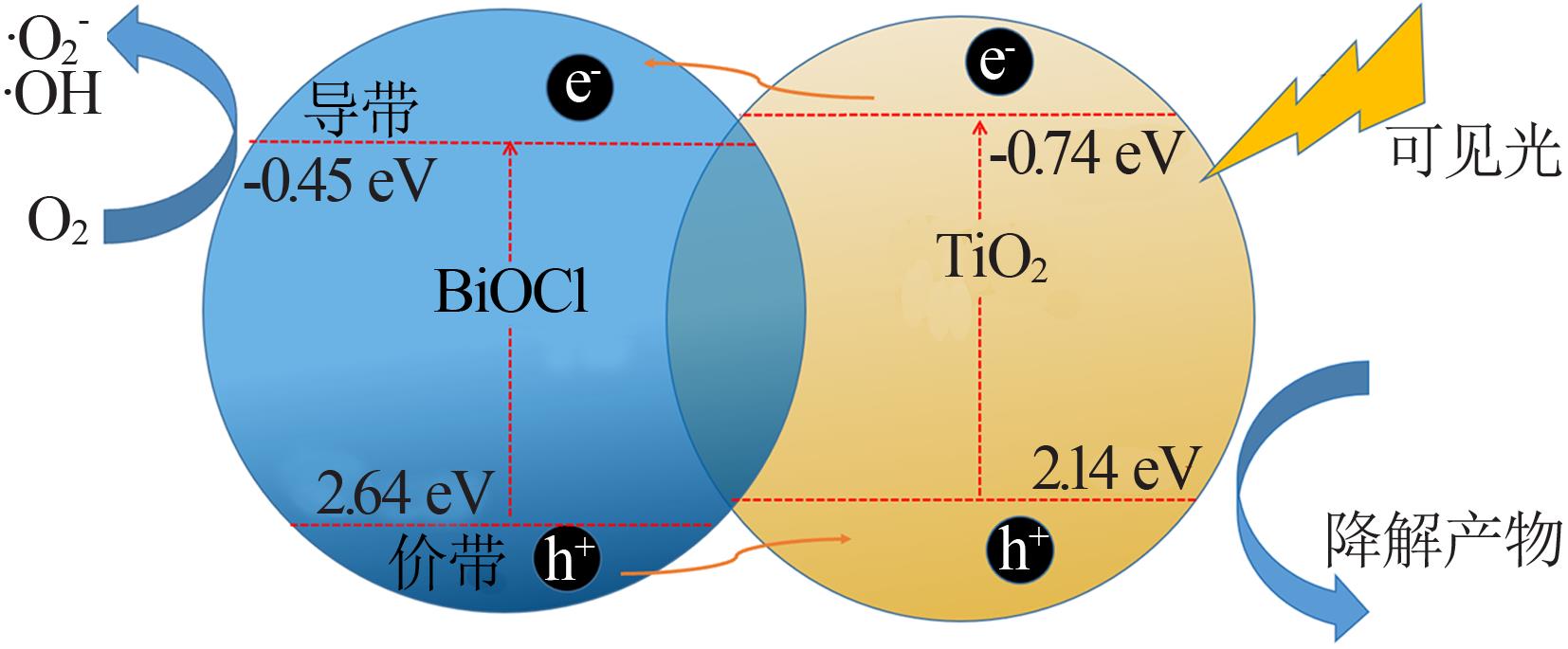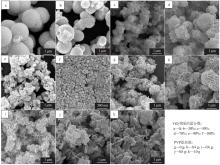Inorganic Chemicals Industry ›› 2022, Vol. 54 ›› Issue (6): 38-45.doi: 10.19964/j.issn.1006-4990.2021-0450
• Reviews and Special Topics • Previous Articles Next Articles
Research progress on photocatalysis by bismuth?based semiconductor composite TiO2
YANG Shuang1( ),ZHAO Siqin1,2,3(
),ZHAO Siqin1,2,3( ),YANG Huiying1
),YANG Huiying1
- 1.College of Chemical and Environmental Science,Inner Mongolia Normal University,Hohhot 010022,China
2.Inner Mongolia Autonomou Region Environmental Chemistry Key Laboratory
3.Collaborative Innovation Center for Water Environment Security of Inner Mongolia Autonomous Region
-
Received:2021-09-22Online:2022-06-10Published:2022-06-22 -
Contact:ZHAO Siqin E-mail:ys1410350082@163.com;zhaosq@imnu.edu.cn
CLC Number:
Cite this article
YANG Shuang,ZHAO Siqin,YANG Huiying. Research progress on photocatalysis by bismuth?based semiconductor composite TiO2[J]. Inorganic Chemicals Industry, 2022, 54(6): 38-45.
share this article
Table 1
Crystal structure data of TiO2"
| TiO2结构 | 晶系 | 带隙能/eV | 参数/nm | 钛氧键长/nm | O—Ti—O 键角/(°) | 密度/ (g?cm-3) | 转化关系 |
|---|---|---|---|---|---|---|---|
| 金红石相(最稳定) | 四方晶系 | 3.00 | a=0.458 4 c=0.295 3 | 0.193 7(4) 0.196 5(2) | 77.7 92.6 | 4.2~4.3 | — |
| 锐钛矿相 | 四方晶系 | 3.20 | a=0.377 6 c=0.948 6 | 0.149 4(4) 0.198 0(2) | 81.2 90.0 | 3.8~3.9 | 910 ℃完全转换为金红石相 |
| 板钛矿相 | 斜方晶系 | 2.96 | a=0.545 b=0.918 c=0.515 | 0.187~0.204 | 77.0~105.0 | 4.12~4.23 | 高于650 ℃转换为金红石相 |
| 1 | FUJISHIMA A, HONDA K.Electrochemical photolysis of water at a semiconductor electrode[J].Nature,1972,238(5358):37-38. |
| 2 | 赵斯琴,王超,杨春花,等.可见光响应(001)晶面纳米TiO2光催化剂的制备及性能研究[J].人工晶体学报,2016,45(5):1216-1222. |
| ZHAO Siqin, WANG Chao, YANG Chunhua,et al.Study on preparation and properties of visible light response(001) facets exposed TiO2 nano photocatalyst[J].Journal of Synthetic Crystals,2016,45(5):1216-1222. | |
| 3 | WANG Danyang, LUO Hui, LIU Liuxie,et al.Adsorption characteristics and degradation mechanism of metronidazole on the surface of photocatalyst TiO2:A theoretical study[J].Applied Surface Science,2019,478:896-905. |
| 4 |
KHAZRAIE A, FOYEVTSOVA K, ELFIMOV I,et al.Oxygen holes and hybridization in the bismuthates[J].Physical Review B,2018,97(7) .Doi:10.1103/physrevb.97.075103 .
doi: 10.1103/physrevb.97.075103 |
| 5 | 林传威.铋基异质结光催化剂的制备及其光催化机理研究[D].杭州:浙江大学,2021. |
| LIN Chuanwei.Synthesis and photocatalytic mechanism of bismu⁃ | |
| th⁃based heterojunction photocatalyst[D].Hangzhou:Zhejiang Uni⁃ | |
| versity,2021. | |
| 6 | HU Jianqiang, LIU Aili, JIN Huile,et al.A versatile strategy for shish⁃kebab⁃like multi⁃heterostructured chalcogenides and enhan⁃ |
| ced photocatalytic hydrogen evolution[J].Journal of the American Chemical Society,2015,137(34):11004-11010. | |
| 7 | LEUNG D, FU Xianliang, WANG Cuifang,et al.Hydrogen production over titania⁃based photocatalysts[J].ChemSusChem,2010,3(6):681-694. |
| 8 | YU Hongtao, SONG Liang, HAO Yufang,et al.Fabrication of pilot-scale photocatalytic disinfection device by installing TiO2 coated helical support into UV annular reactor for strengthening sterilization[J].Chemical Engineering Journal,2016,283:1506-1513. |
| 9 | XIANG Zhenbo, WANG Yi, JU Peng,et al.Controlled synthesis and photocatalytic antifouling properties of BiVO4 with tunable morphologies[J].Journal of Electronic Materials,2017,46(2):758- |
| 765 | |
| 10 | TRUONG-PHUOC L, CHRISTOFORIDIS K C, VIGNERON F,et al.Layer⁃by⁃layer photocatalytic assembly for solar light⁃activated self⁃decontaminating textiles[J].ACS Applied Materials & Interfaces,2016,8(50):34438-34445. |
| 11 | LU Dingze, CHAI Wuqiong, YANG Minchen,et al.Visible light induced photocatalytic removal of Cr(Ⅵ) over TiO2-based nano⁃ |
| sheets loaded with surface⁃enriched CoO x nanoparticles and its synergism with phenol oxidation[J].Applied Catalysis B:Environmental,2016,190:44-65. | |
| 12 | WANG Dawei, LI Yi, LI PUMA G,et al.Photoelectrochemical cell for simultaneous electricity generation and heavy metals recovery from wastewater[J].Journal of Hazardous Materials,2017, 323:681-689. |
| 13 | 夏泽林,刘世民,郭玉,等.TiO2制备改性及光催化应用研究进展[J].中国陶瓷工业,2020,27(1):41-45. |
| XIA Zelin, LIU Shimin, GUO Yu,et al.Preparation,modification and photocatalytic application progress of nano-TiO2 [J].China Ceramic Industry,2020,27(1):41-45. | |
| 14 | ZIKRIYA M, NADAF Y F, BHARATHY P V,et al.Luminescent characterization of rare earth Dy3+ ion doped TiO2 prepared by simple chemical co⁃precipitation method[J].Journal of Rare Ear⁃ ths,2019,37(1):24-31. |
| 15 | SHENG Yuqiang, WEI Zhen, MIAO Hong,et al.Enhanced organic pollutant photodegradation via adsorption/photocatalysis synergy using a 3D g-C3N4/TiO2 free⁃separation photocatalyst[J].Chemical Engineering Journal,2019,370:287-294. |
| 16 |
WANG Yutong, SHEN Guoqiang, ZHANG Yuxi,et al.Visible⁃light⁃induced unbalanced charge on NiCoP/TiO2 sensitized system for rapid H2 generation from hydrolysis of ammonia borane[J].Applied Catalysis B:Environmental,2020,260.Doi:10.1016/j.apcatb.2019.118183 .
doi: 10.1016/j.apcatb.2019.118183 |
| 17 | WU Shiqun, TAN Xianjun, LEI Juying,et al.Ga-doped and Pt-loaded porous TiO2-SiO2 for photocatalytic nonoxidative coupling of methane[J].Journal of the American Chemical Society,2019,141(16):6592-6600. |
| 18 | QI Lifang, CHENG Bei, YU Jiaguo,et al.High⁃surface area mesoporous Pt/TiO2 hollow chains for efficient formaldehyde decomposition at ambient temperature[J].Journal of Hazardous Materials,2016,301:522-530. |
| 19 | WETCHAKUN N, CHAINET S, PHANICHPHANT S,et al.Efficient photocatalytic degradation of methylene blue over BiVO4/TiO2 nanocomposites[J].Ceramics International,2015,41(4):5999-6004. |
| 20 | SHI Hongfei, YU Yanchun, ZHANG Yi,et al.Polyoxometalate/TiO2/Ag composite nanofibers with enhanced photocatalytic performance under visible light[J].Applied Catalysis B:Environmental,2018,221:280-289. |
| 21 | GE Lei, ZHANG Xianhua.Synthesis of novel visible light driven BiVO4 photocatalysts via microemulsion process and its photocatalytic performance[J].Journal of Inorganic Materials,2009,24(3):453-456. |
| 22 | 胡佳凯,罗晓祝,陈维科,等.BiVO4复合材料的制备及应用进展[J].天津化工,2019,33(6):1-3. |
| HU Jiakai, LUO Xiaozhu, CHEN Weike,et al.Preparation and application progress of BiVO4 composites[J].Tianjin Chemical Industry,2019,33(6):1-3. | |
| 23 | COOPER J K,GUL S, TOMA F M,et al.Electronic structure of monoclinic BiVO4 [J].Chemistry of Materials,2014,26(18):5365-5373. |
| 24 |
TIAN Hailin, WU Huanhuan, FANG Yanfen,et al.Hydrothermal synthesis of m-BiVO4/t-BiVO4 heterostructure for organic pollutants degradation:Insight into the photocatalytic mechanism of exposed facets from crystalline phase controlling[J].Journal of Hazardous Materials,2020,399.Doi:10.1016/j.jhazmat.2020.123159 .
doi: 10.1016/j.jhazmat.2020.123159 |
| 25 | LV Yanran, LIU Chaojun, HE Runkai,et al.BiVO4/TiO2 heterojunction with enhanced photocatalytic activities and photoelectochemistry performances under visible light illumination[J].Materials Research Bulletin,2019,117:35-40. |
| 26 | ZHU Xiaodi, ZHANG Fan, WANG Mengjiao,et al.A shuriken⁃shaped m-BiVO4/{0 0 1}-TiO2 heterojunction:Synthesis,structure and enhanced visible light photocatalytic activity[J].Applied Catalysis A:General,2016,521:42-49. |
| 27 | MONFORT O, ROCH T, GREGOR M,et al.Photooxidative properties of various BiVO4/TiO2 layered composite films and study of their photocatalytic mechanism in pollutant degradation[J].Journal of Environmental Chemical Engineering,2017,5(5):5143-5149. |
| 28 | WANG Shuyun, LI Wenjun, CHEN Feiwu,et al.Visible light⁃driven BiVO4/TiO2 composite photocatalysts:Preparation methods and photocatalytic performance[J].Australian Journal of Che⁃ mistry,2015,68(8):1268-1275. |
| 29 | YUAN Huimin, LIU Jinlong, LI Jun,et al.Designed synthesis of a novel BiVO4-Cu2O-TiO2 as an efficient visible⁃light⁃responding photocatalyst[J].Journal of Colloid and Interface Science,2015,444:58-66. |
| 30 | XIANG Quanjun, YU Jiaguo, WONG P K.Quantitative characterization of hydroxyl radicals produced by various photocatalysts[J].Journal of Colloid and Interface Science,2011,357(1):163-167. |
| 31 | ZHAO Yanyan, WANG Yongbo, LIU Enzhou,et al.Bi2WO6 nanoflowers:An efficient visible light photocatalytic activity for ceftriaxone sodium degradation[J].Applied Surface Science,2018,436:854-864. |
| 32 | YANG Chengyu, HUANG Yan, LI Feng,et al.One⁃step synthesis of Bi2WO6/TiO2 heterojunctions with enhanced photocatalytic and superhydrophobic property via hydrothermal method[J].Jo⁃ |
| urnal of Materials Science,2016,51(2):1032-1042. | |
| 33 | 白照杲,胡芸,游素珍,等.Bi2WO6-TiO2复合光催化剂对Cu-EDTA复合污染的高效光催化协同处理[J].化工进展,2017,36(6):2164-2170. |
| BAI Zhaogao, HU Yun, YOU Suzhen,et al.Synergetic treatment of Cu-EDTA on Bi2WO6-TiO2 composite photocatalysts[J].Che⁃ | |
| mical Industry and Engineering Progress,2017,36(6):2164-2170. | |
| 34 | 马占营,李小博,邓玲娟,等.TiO2/Bi2WO6纳米异质结的制备及其可见光光催化性能[J].分子催化,2016,30(6):575-582. |
| MA Zhanying, LI Xiaobo, DENG Lingjuan,et al.Preparation and visible⁃light⁃driven photocatalytic performance of TiO2/Bi2WO6 nano⁃heterostructure[J].Journal of Molecular Catalysis(China),2016,30(6):575-582. | |
| 35 | GUO Qiyao, HUANG Yunfang, XU Hui,et al.The effects of solvent on photocatalytic properties of Bi2WO6/TiO2 heterojunction under visible light irradiation[J].Solid State Sciences,2018,78:95-106. |
| 36 | LV Ning, LI Yingying, HUANG Zhuolin,et al.Synthesis of GO/TiO2/Bi2WO6 nanocomposites with enhanced visible light photocatalytic degradation of ethylene[J].Applied Catalysis B:Environmental,2019,246:303-311. |
| 37 | LEI Yongqian, WANG Guanhua, SONG Shuyan,et al.Synthesis,characterization and assembly of BiOCl nanostructure and their photocatalytic properties[J].CrystEngComm,2009,11(9):1857- |
| 1862. | |
| 38 | CHENG Hefeng, HUANG Baibiao, DAI Ying.Engineering BiOX(X=Cl,Br,I) nanostructures for highly efficient photocatalytic applications[J].Nanoscale,2014,6(4):2009-2026. |
| 39 | JIANG Jing, ZHAO Kun, XIAO Xiaoyi,et al.Synthesis and facet⁃dependent photoreactivity of BiOCl single⁃crystalline nanoshee⁃ |
| ts[J].Journal of the American Chemical Society,2012,134(10):4473-4476. | |
| 40 | AO Minlin, LIU Kun, TANG Xuekun,et al.BiOCl/TiO2/diatomite composites with enhanced visible⁃light photocatalytic activity for the degradation of rhodamine B[J].Beilstein Journal of Nanotechnology,2019,10:1412-1422. |
| 41 | QU Xiaofei, ZHAO Xiaohui, LIU Meihua,et al.BiOCl/TiO2 composite photocatalysts synthesized by the sol-gel method for enhanced visible⁃light catalytic activity toward methyl orange[J].Journal of Materials Research,2020,35(22):3067-3078. |
| 42 | SÁNCHEZ-RODRÍGUEZ D, MÉNDEZ MEDRANO M G, REMITA H et al.Photocatalytic properties of BiOCl-TiO2 composites for phenol photodegradation[J].Journal of Environmental Chemical Engineering,2018,6(2):1601-1612. |
| 43 | LI Wei, TIAN Yi, LI Huan,et al.Novel BiOCl/TiO2 hierarchical composites:Synthesis,characterization and application on photocatalysis[J].Applied Catalysis A:General,2016,516:81-89. |
| 44 | HE Rongan, LIU Haijuan, LIU Huimin,et al.S-scheme photocatalyst Bi2O3/TiO2 nanofiber with improved photocatalytic performance[J].Journal of Materials Science & Technology,2020,52:145-151. |
| 45 | WU Zhi, YUAN Ding, LIN Sheng,et al.Enhanced photoelectrocatalytic activity of Bi2S3-TiO2 nanotube arrays hetero⁃structure under visible light irradiation[J].International Journal of Hydrogen Energy,2020,45(56):32012-32021. |
| 46 | POLICE A K R, VATTIKUTI S V P, MANDARI K K,et al.Bismuth oxide cocatalyst and copper oxide sensitizer in Cu2O/TiO2/Bi2O3 ternary photocatalyst for efficient hydrogen production under solar light irradiation[J].Ceramics International,2018,44(10):11783-11791. |
| 47 | JIAN Zicong, HUANG Shaobin, CAO Yaya,et al.Hydrothermal preparation and characterization of TiO2/BiVO4 composite catalyst and its photolysis of water to produce hydrogen[J].Photochemistry and Photobiology,2016,92(3):363-370. |
| 48 | YUAN Lan, LU Kangqiang, ZHANG Fan,et al.Unveiling the interplay between light⁃driven CO2 photocatalytic reduction and car⁃ |
| bonaceous residues decomposition:A case study of Bi2WO6-TiO2 binanosheets[J].Applied Catalysis B:Environmental,2018,237:424-431. | |
| 49 |
PAN Qin, ZHANG Haifeng, YANG Yaping,et al.3D brochosomes⁃
doi: 10.1002/ |
|
TiO like 2 /WO3/BiVO4 arrays as photoanode for photoelectroche⁃
doi: 10.1002/ |
|
|
mical hydrogen production[J].Small,2019,15(28).Doi:10.1002/
doi: 10.1002/ |
|
|
smll.201900924.
doi: 10.1002/ |
| [1] | SUN Yanlong, YUAN Guangsheng, WANG Hongjun. Study on palladium modified mesoporous TiO2 nanorods for efficient photodegradation of tetracycline [J]. Inorganic Chemicals Industry, 2024, 56(9): 147-153. |
| [2] | MA Yihong, CHEN Xingtao, TANG Lei. Treatment of printing wastewater by chemical coagulation-TiO2/g-C3N5 photocatalytic degradation [J]. Inorganic Chemicals Industry, 2024, 56(10): 151-158. |
| [3] | ZHAN Hongren, TIAN Feng, ZHANG Xianzhen, MA Yugui, KOU Liping, LIU Peng. Experimental study on preparation of high performance foam glass ceramics from waste rock wool [J]. Inorganic Chemicals Industry, 2024, 56(1): 96-101. |
| [4] | SONG Zhijia, WANG Suisui, KUANG Qin. Hollow Cu-doped TiO2 for enhancing photocatalytic CO2 reduction performance [J]. Inorganic Chemicals Industry, 2023, 55(8): 45-50. |
| [5] | CHEN Zhangxu, ZHU Danchen, FU Minglian. Study on preparation of g-C3N4/TiO2 composites and application for rhodamine B removal [J]. Inorganic Chemicals Industry, 2023, 55(7): 130-136. |
| [6] | XU Xiaobing,LI Xu,YANG Xu,XU Xiaoyong. Effect of firing temperature on properties of MgO-TiO2 composite inorganic ceramic microfilter membrane support [J]. Inorganic Chemicals Industry, 2022, 54(8): 85-89. |
| [7] | HOU Yan,GAO Chengjuan,WU Xizhe,ZI Xuechi,XIE Lu,YANG Haizheng,YAN Yuxing. Theoretical study on effect of nitrogen doping on photoelectric properties of rutile TiO2 [J]. Inorganic Chemicals Industry, 2022, 54(6): 90-95. |
| [8] | ZHANG Farong,FAN Tiantian,GUO Yanyun,LI Lu,LIU Bingguang,LI Jiansheng. Research progress on self-cleaning film materials [J]. Inorganic Chemicals Industry, 2022, 54(4): 74-80. |
| [9] | FU Yong,XU Wenqi,ZHAO Qiang,RAN Ruiquan,LI Jun,JIN Yang. Study on preparation of silver-doped titanium dioxide/activated carbon composite material and its photocatalytic performance [J]. Inorganic Chemicals Industry, 2022, 54(2): 117-122. |
| [10] | Liu Xingyu,Jia Yuanyuan,Wu Shufeng,Tang Zhonghua,Zhang Peng,Liu Junqiang,Pu Xin. Research progress of Ce-based SCR denitration catalysts [J]. Inorganic Chemicals Industry, 2021, 53(8): 15-20. |
| [11] | Zhang Lan,Tan Haolei,Ma Huizhong,Luo Aoxiang,Wang Jiping. Study on preparation and photocatalytic performance of nano-TiO2 films co-doped with nickel and carbon [J]. Inorganic Chemicals Industry, 2021, 53(4): 107-111. |
| [12] | WU Lina,ZHANG Xiangjun,LIN Qingxian. Synthesis and antibacterial performance of γ-Fe2O3/sorbic acid/Ag-TiO2 [J]. Inorganic Chemicals Industry, 2021, 53(12): 156-162. |
| [13] | Zhang Aiwen,Chong Yanzhu,Gao Guanjun. Preparation of Ag modified TiO2 nano-fiber by electrostatic spinning for MB photo-degradation [J]. Inorganic Chemicals Industry, 2021, 53(10): 125-128. |
| [14] | Wang Zinan,Chen Kui,Zhu Jiawen,Zhang Yurong,Lin Farong,Zhou Xiaokui. Effects of crystal seeds and salt dopants on phase transformation of TiO2 in calcination process [J]. Inorganic Chemicals Industry, 2020, 52(3): 45-50. |
| [15] | Zhu Jiaxin,Xiong Yuhua,Guo Rui. Research progress in modification of TiO2 photocatalyst [J]. Inorganic Chemicals Industry, 2020, 52(3): 23-27. |
| Viewed | ||||||
|
Full text |
|
|||||
|
Abstract |
|
|||||
|
||
